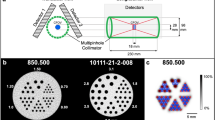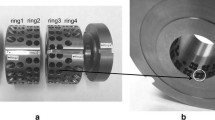Abstract
Objectives
Pinhole SPECT which permitsin vivo high resolution 3D imaging of physiological functions in small animals facilitates objective assessment of pharmaceutical development and regenerative therapy in pre-clinical trials. For handiness and mobility, the miniature size of the SPECT system is useful. We developed a small animal SPECT system based on a compact high-resolution gamma camera fitted to a pinhole collimator and an object-rotating unit. This study was aimed at evaluating the basic performance of the detection system and the feasibility of small animal SPECT imaging.
Methods
The gamma camera consists of a 22 × 22 pixellated scintillator array of 1.8 mm × 1.8 mm × 5 mm NaI(TI) crystals with 0.2-mm gap between the crystals coupled to a 2″ flat panel position-sensitive photomultiplier tube (Hamamatsu H8500) with 64 channels. The active imaging region of the camera was 43.8 mm × 43.8 mm. Data acquisition is controlled by a personal computer (Microsoft Windows) through the camera controller. Projection data over 360° for SPECT images are obtained by synchronizing with the rotating unit. The knife-edge pinhole collimators made of tungsten are attached on the camera and have 0.5-mm and 1.0-mm apertures. The basic performance of the detection system was evaluated with99mTc and201T1 solutions. Energy resolution, system spatial resolution and linearity of count rate were measured. Rat myocardial perfusion SPECT scans were sequentially performed following intravenous injection of201T1C1. Projection data were reconstructed using a previously validated pinhole 3D-OSEM method.
Results
The energy resolution at 140 keV was 14.8% using a point source. The system spatial resolutions were 2.8-mm FWHM and 2.5-mm FWHM for99mTc and201T1 line sources, respectively, at 30-mm source distance (magnification factor of 1.3) using a 1.0-mm pinhole. The linearity between the activity and count rate was good up to 10 kcps. In a rat study, the left ventricular walls were clearly visible in all scans.
Conclusions
We developed a compact SPECT system using compact gamma camera for small animals and evaluated basic physical performances. The present system may be of use for quantitation of biological functions such as myocardial blood flow in small animals.
Similar content being viewed by others
References
Meikle SR, Eberl S, Iida H. Instrumentation and methodology for quantitative pre-clinical imaging studies.Curr Pharm Des 2001; 7 (18): 1945–1966.
Chatziioannou AF. PET scanners dedicated to molecular imaging of small animal models.Mol Imaging Biol 2002; 4 (1): 47–63.
Hirai T, Nohara R, Ogoh S, Chen LG, Kataoka K, Li XH, et al. Serial evaluation of fatty acid metabolism in rats with myocardial infarction by pinhole SPECT.J Nucl Cardiol 2001; 8 (4): 472–481.
Scherfler C, Donnemiller E, Schocke M, Dierkes K Decristoforo C, Oberladstätter M, et al. Evaluation of striatal dopamine transporter function in rats byin vivo β-[123I]CIT pinhole SPECT.Neurolmage 2002; 17: 128–141.
Acton PD, Choi SR, Plössl K, Kung HF. Quantification of dopamine transporters in the mouse brain using ultra-high resolution single-photon emission tomography.Eur J Nucl Med 2002; 29 (5): 691–698.
Aoi T, Watabe H, Deloar HM, Ogawa M, Teramoto N, Kudomi N, et al. Absolute quantitation of regional myocardial blood flow of rats using dynamic pinhole SPECT. In Conference Record of 2002 IEEE Nuclear Science Symposium and Medical Imaging Conference (CD-ROM), 2003: Mll-185.
Jeavons AP, Chandler RA, Dettmar CAR. A 3D HIDAC-PET camera with sub-millimetre resolution for imaging small animals.IEEE Trans Nucl Sci 1999; 46 (3): 468–473.
Seidel J, Vaquero JJ, Green MV. Resolution uniformity and sensitivity of the NIH ATLAS small animal PET scanner: comparison to simulated LSO scanners without depth-of-interaction capability.IEEE Trans Nucl Sci 2003; 50 (5): 1347–1350.
Tai YC, Chatziioannou AF, Yang Y, Silverman RW, Meadors K, Siegel S, et al. MicroPET II: design, development and initial performance of an improved microPET scanner for small-animal imaging.Phys Med Biol 2003; 48: 1519–1537.
Jaszczak RJ, Li J, Wang H, Zalutsky MR, Coleman RE. Pinhole collimation for ultra-high-resolution, small-field-of-view SPECT.Phys Med Biol 1994; 39: 425–437.
Weber DA, Ivanovic M, Franceschi D, Strand SE, Erlandsson K, Franceschi M, et al. Pinhole SPECT: an approach toin vivo high resolution SPECT imaging in small laboratory animals.J Nucl Med 1994; 35 (2): 342–348.
Ishizu K, Mukai T, Yonekura Y, Pagani M, Fujita T, Magata Y, et al. Ultra-high resolution SPECT system using four pinhole collimators for small animal studies.J Nucl Med 1995; 36 (12): 2282–2287.
Ogawa K, Kawade T, Nakamura K, Kubo A, Ichihara T. Ultra high resolution pinhole SPECT for small animal study.IEEE Trans Nucl Sci 1998; 45 (6): 3122–3126.
Moore SC, Zimmerman RE, Mahmood A, Meilen R, Lim CB. A triple-detector, multiple-pinhole system for SPECT imaging rodents. [Abstract]J Nucl Med 2004; 45 (suppl): 97–98.
Beekman FJ, van der Have F, Vastenhouw B, van der Linden AJ, van Rijk PP, Burbach JP, et al. U-SPECT-I: a novel system for submillimeter-resolution tomography with radiolabeled molecules in mice.J Nucl Med 2005; 46 (7): 1194–1200.
Sun M, Izaguirre EW, Funk T, Hwang AB, Carver J, Thompson S, et al. A CdZnTe-based high-resolution microSPECT system. [Abstract]J Nucl Med 2005;46 (suppl 2): p170.
Lackas C, Hoppin JW, Schramm NU. Performance analysis of a submillimeter-resolution multi-pinhole SPECT small-animal imaging system. [Abstract]J Nucl Med 2005; 46 (suppl 2):p171.
Zeniya T, Watabe H, Aoi T, Kim KM, Teramoto N, Hayashi T, et al. A new reconstruction strategy for image improvement in pinhole SPECT.Eur J Nucl Med Mol Imaging 2004; 31(8): 1166–1172.
Liu Z, Kastis GA, Stevenson GD, Barrett HH, Furenlid LR, Kupinski MA, et al. Quantitative analysis of acute myocardial infarct in rat hearts with ischemia-reperfusion using a high-resolution stationary SPECT system.J Nucl Med 2002; 43 (7): 933–939.
Schramm NU, Ebel G, Engeland U, Schurrat T, Béhé M, Behr TM. High-resolution SPECT using multipinhole collimation.IEEE Trans Nucl Sci 2003; 50 (3): 315–320.
Schramm N, Wirrwar A, Sonnenberg F, Hailing H. Compact high resolution detector for small animal SPECT.IEEE Trans Nucl Sci 2000; 47 (3): 1163–1167.
McElroy DP, MacDonald LR, Beekman FJ, Wang Y, Patt BE, Iwanczyk JS, et al. Performance evaluation of A-SPECT: a high resolution desktop pinhole SPECT system for imaging small animals.IEEE Trans Nucl Sci 2002; 49 (5): 2139–2147.
Wojcik R, Goode AR, Smith MF, Beller GA, Ellman PI, Majewski S, et al. Dedicated small field of view SPECT system based on a 5″ PSPMT and crystal scintillator array for high resolution small animal cardiac imaging. In Conference Record of 2003 IEEE Nuclear Science Symposium and Medical Imaging Conference (CD-ROM), 2004: M3-43.
Smith MF, Jaszczak RJ. The effect of gamma ray penetration on angle-dependent sensitivity for pinhole collimation in nuclear medicine.Med Phys 1997; 24 (11): 1701–1709.
Metzler SD, Bowsher JE, Smith MF, Jaszczak RJ. Analytical determination of pinhole collimator sensitivity with penetration.IEEE Trans Med Imag 2001; 20 (8): 730–741.
Deloar HM, Watabe H, Kim KM, Aoi T, Kunieda E, Fujii H, et al. Optimization of the width of the photopeak energy window in the TDCS technique for scatter correction in quantitative SPECT.IEEE Trans Nucl Sci 2004; 51 (3): 625–630.
Anger HO. Radioisotope cameras. In:Instrumentation in nuclear medicine, Hine GJ (ed), New York; Academic, 1967:485–552.
Bequé D, Vanhove C, Andreyev A, Nuyts J, Defrise M. Correction for impact camera motion and resolution recovery in pinhole SPECT. In Conference Record of 2004 IEEE Nuclear Science Symposium and Medical Imaging Conference (CD-ROM), 2005: M2-173.
Cao Z, Bal G, Acton PD. Pinhole SPECT reconstruction with resolution recovery. [Abstract]J Nucl Med 2005;45 (suppl 2): 109–110.
Iida H, Eberl S. Quantitative assessment of regional myocardial blood flow with thallium-201 and SPECT.J Nucl Cardiol 1998; 5: 313–331.
Author information
Authors and Affiliations
Corresponding author
Rights and permissions
About this article
Cite this article
Zeniya, T., Watabe, H., Aoi, T. et al. Use of a compact pixellated gamma camera for small animal pinhole SPECT imaging. Ann Nucl Med 20, 409–416 (2006). https://doi.org/10.1007/BF03027376
Received:
Accepted:
Issue Date:
DOI: https://doi.org/10.1007/BF03027376




